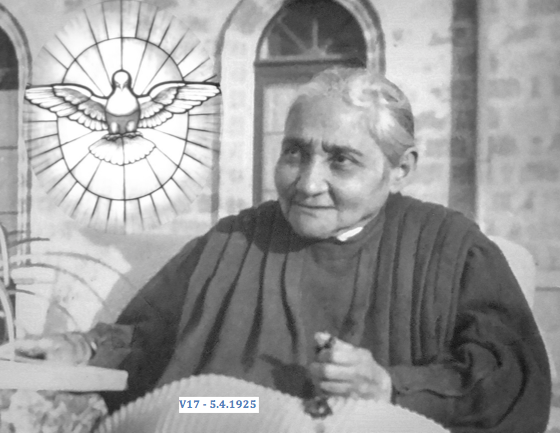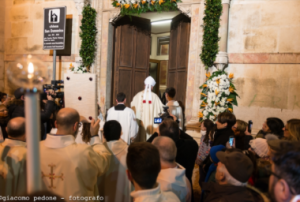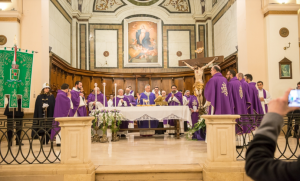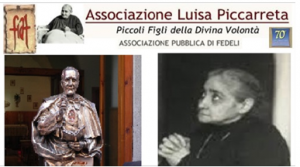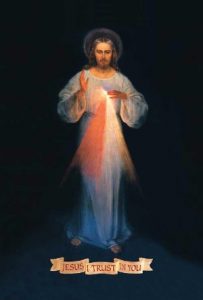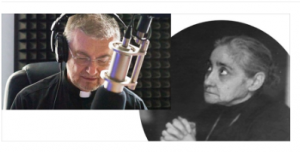[gview file=”http://luisapiccarreta.co/wp-content/uploads/2018/03/Newsletter-No-190-2018-MARCH.pdf”]
2/26 The Archbishop opens the Holy Door in the city of Corato
Click here for website
On Thursday February 22, the Association Luisa Piccarreta joyfully joined the celebrations of the Saint Dominic church parishioners for the opening of the Parish Jubilee and of the Holy Door. It is a time of grace that has been offered to the entire city of Corato, to remember the five hundred years of the presence of the Dominican friars in the city. The Church of San Domenico is one of the oldest religious structures in Corato; It was born in the early 1200s as a Benedictine monastery, then it underwent a transformation in the sixteenth century when, thanks to the support of the Marquis Ladislao D’Aquino, in 1518, it passed to the Dominicans.
Luisa Piccarreta is the link between the Dominicans and the Little Children of the Divine Will. We should remember that Luisa became a Dominican tertiary taking the name of Magdalene and embraced Saint Dominic’s ideal of life: love for the salvation of souls through the gift of Truth.
The Jubilee Year was officially opened by His Excellency Monsignor Leonardo D’Ascenzo who presided over the Solemn Eucharistic Celebration .
«This Jubilee year begins during the Lent – the Archbishop commented in his homily – and as Pope Francis said it is a period that gives us so many opportunities to start loving again, and reminds us that the heart of God is always open to us to give goodness, mercy and forgiveness … This is my wish for this parish jubilee: to open our hearts to the love of God to receive it and then to give it to each other.
The Holy Door is Jesus – Monsignor D’Ascenzo highlighted – and all of us, when we…through the Holy Door, want to say that we want to go through Jesus, we want to follow Him. Jesus Himself, in the Gospel of John, identifies with the door (John 10: 9): “I am the door. If anyone enters by me, he will be saved. And it is Jesus Himself who in the writings of Luisa defines His Humanity and the knowledge on the Divine Will as the Door that opens the Kingdom of the Divine Will and allows us to live in it.
“The first door I will open will be my Will” (Vol.17- May 30, 1925) and “just as the human will has its doors, its stairways in order to descend into the abyss of evils, so the Divine Will has Its doors, Its stairways in order to ascend, Its heavens, Its immense goods…Each knowledge that regards It is a door that is opened, it is a way that opens before us, which we must travel. See then, the great good of the many knowledges I have manifested to you – Jesus said to Luisa- they are as many doors that facilitate for you the entrance into Its Kingdom; and in each door I placed an Angel as guard, that he may hold your hand and lead you safely into the regions of the Divine Will. (Vol. 32.- May 28 1933)
Fiat!
• The next appointment with the community of San Domenico will be on March 3, in the context of the celebrations for the week of obedience (28 February – 4 March) when the Association Luisa Piccarreta attends the conference held by the Dominican father Francesco Giacomo Maria on importance of the Dominican laity.
Antonella
Photos – Corato welcomes Archbishop, Monsignor Leonardo D’Ascenzo
Click here for photos
St. Annibale and Luisa Piccarreta: two souls united in the Divine Will
St. Annibale and the Servant of God, Luisa Piccarreta
Click here for website
“These days will surely be full of grace for everyone“. With those words, on Sunday February 4, Father Angelo Sardone, Rogationist of the community of Bari, began his talk when the relics of Saint Annibale Maria di Francia arrived at the house of the servant of God Luisa Piccarreta. Yes, they were really days of grace and blessing and we can confirm now at the conclusion of the week of spirituality that was conceived in the context of the initiatives for the 90th anniversary of the opening of the House of the Daughters of Divine Zeal.
Saint Hannibal, with the presence of his relics, spiritually enriched the city of Corato staying for eight days at the Church Santa Maria Greca, where the tomb of the Servant of God Luisa Piccarreta is guarded. It was indeed touching to be simultaneously in front of two models of holiness linked together by an intense spiritual relationship, and united – we could say – by one single mission: to live and spread the Divine Will.
“A crusade of prayer a4nd knowledge“, Father Angelo defined the intense program of the event. It was characterized daily by moments of prayer and formative and spiritual activities that allowed us to know more about the figure and the work of the Saint from Messina in correlation especially with Luisa, the little daughter of the Divine Will.
The venture of Annibale Maria Di Francia started in 1878 in the Avignone district, the worst slum in Messina at that time; the meeting with Francesco Zancone, a blind beggar changed his life. Father Annibale was rich, from a noble family and was admired for his culture. He could have had an extraordinary career, but he left everything and went into the midst of the slums of Messina. There he worked incessantly for the temporal and spiritual good of his neighbor, through the education and sanctification of children and boys, evangelization and relief to the poorest.
He was enraptured, since adolescence, by the gospel expression: “The harvest is plentiful, but the laborers are few; therefore pray earnestly to the Lord of the harvest to send out laborers into his harvest “(Mt 9:38; Lk 10: 2), and for this noble cause he spent all his energies.
The Rogate (Ask) thus became his life program. To this end, he founded two religious Congregations: the Rogationists and the Daughters of the Divine Zeal, and promoted numerous initiatives to spread among the faithful the awareness of the need to pray intensely for vocations.
He himself deeply loved his priesthood; He lived it consistently, and was fully convinced that it is only through the work of numerous holy priests that humanity can be saved.
For living and spreading this charism with admirable zeal, he was recognized by the Church as” distinguished Apostle of Prayer for Vocations” and Pope John Paul II called him “authentic forerunner and zealous master of modern vocation ministry”.
His message is particularly timely today, in the third millennium. The “global village” that our planet has become, confined by the communications network and political, economic and social interests, feels an urgent need of good, hard-working apostles who work for the Kingdom..
Priests, consecrated persons and all Christians are the “laborers of the Gospel” and are the fruit of prayer. It is necessary to pray to the Lord of the harvest so that many people, responding with their own generous FIAT to the call, can become workers of the harvest, new “apostles of the Divine Will“- as Jesus himself call them in Luisa’swritings – ready to work for salvation and sanctification by communicating to all the precious truths of the Divine Will.
“…once I have completed everything, I will entrust my Kingdom to my ministers, so that, like second apostles of the Kingdom of my Will, they may be the criers of It”. (Vol. XX – November 6,1926)
Therefore, we can see how St. Annibale’ s “Rogate” and Luisa’s “Fiat” interweave and walk in unison; Luisa and St. Annibale, in the plans of the Divine Providence, mutually helped and influenced each other, by communicating to each other the charisms with which the Lord had enriched their souls for the good of the Church. Pope Benedict XVI said “true friendship, in addition to being a relationship between people, it is a mutual help and spiritual journey. This is a characteristic of Saints: they cultivate friendship because it is one of the noblest manifestations of the human heart and has something divine about it”.
“Do you think that the coming of Father Di Francia, who shows so much interest and who has taken to heart the publication of what regards my Will, came by chance? No, no – I Myself disposed it. It is a providential act of the Supreme Will that wants him as first apostle of the Divine Fiat and proclaimer of It. And since he happens to be the founder of an order, it is easier for him to approach bishops, priests and people, also within his own institute, in order to proclaim the Kingdom of my Will. This is why I assist him so much and I give him special light, because in order to understand my Will it takes great graces – not little lights, but sun, to comprehend a Divine, Holy and Eternal Will, as well as great disposition on the part of the one to whom this office is entrusted”. (Vol. XX – November 6,1926)
The ministers are cooperators, guardians and depositaries of the knowledge, goods and prodigies that are in the Divine Will. So, just as He had the priesthood before His coming in order to prepare the people, and the priesthood of His Church in order to confirm His coming and everything He did and said, so – Jesus said- “I will I have the priesthood of the Kingdom of my Will”.
The many surprising truths revealed to Luisa will be the inexhaustible fount from which all will draw celestial life and terrestrial happiness “…how happy they will feel – those who, with yearning, will drink in large gulps from these founts of my knowledges – Jesus said – because they contain the virtue of bringing the life of Heaven, and of banishing any unhappiness”. For this reason “I enjoy that more of my ministers get to know that there is this treasure so great, of making known the Kingdom of my Divine Will; and I use this to form the first priests of my coming Kingdom of my Fiat. My daughter, it is a great necessity to form the first priests; they will serve Me like the Apostles served Me to form my Church; and the ones who will occupy themselves with these writings in order to publish them, putting them out to print them – to make them known, will be the new evangelists of the Kingdom of my Supreme Will”. (Vol. XXIII, January 18, 1928)
It is precisely to support these new apostles of the Kingdom, within the Association Luisa Piccarreta a mission was born and takes the name Spiritual Mother for Priests. The souls who are part of it aim to spiritually adopt a priest, praying for him and sharing with him, in the Divine Will, his priestly life, a life of offering to Christ and to His Church, so that the flock entrusted to him may walk towards the Kingdom of the Fiat Voluntas Tua already on earth. And it was a very great moment on Saturday evening, when during the celebration of Holy Mass some members of the Mission wished to join the Union of Prayer for Vocations, according to the spirit that animated the life and work of St. Annibale sanctioning, also in this case, the profound spiritual bond between the Little Children of the Divine Will and the daughters and sons of Father Annibale.
Fiat!
Antonella
1/13 Prayer for each day from Ash Wednesday to Divine Mercy Sunday
Prayer of the little children of the Divine Will
For each day from Ash Wednesday to Divine Mercy Sunday
Heavenly Father, In the Name of Jesus, In the Unity, Love and Power of the Holy Spirit, Under the Mantle of Mary Our Blessed Mother, with all the Angels and Saints, and through the Intercession of The Servant of God Luisa Piccarreta, we, the little children of the Divine Will, echo her Prayer to help fulfill her task, to repair and re-do all the acts, thoughts, words and deeds of all souls, past, present and future, and to hasten the Salvation and Sanctification of mankind, and with our voice, give You, Triune God, the Divine Glory as if it was done by all in a Divine Manner, as You Originally Wanted from Adam and his children. And so we say:
‘Heavenly Father, we come to Your Throne to bring to You Your dear children, broken and separated from You, so that You may bind and re-tie once again that Divine Will which was severed from You by Adam. We the little children of Your Most Holy Divine Will asks this of You and we take on the commitment to satisfy You for everyone. Please bind again the human will with the Divine Will bringing the Kingdom of Your Will so that It may come and Reign upon earth as it is in Heaven. Nothing is denied to Your little ones because what they ask is nothing other than the Echo of Your Own Divine Will and of what You Yourself Want.’
We pledge to pray these prayers each day from Ash Wednesday to Divine Mercy Sunday,
for the complete healing and restoration of all Your children and situations:
February 14 – For Our Holy Father Pope Frances, and for all Popes from Peter to the last
February 15 – For all Cardinals, Bishops, Priests and Deacons of all time
February 16 – For all Seminarians, all Religious men and women of all time
February 17 – For all teachers and Promoters of the Faith of all time
February 18 – For all Fathers, Adoptive Fathers, Grandfathers, throughout the generations
February 19 – For all Mothers, Adoptive Mothers, Grandmothers throughout the generations
February 20 – For all the unborn, newborns, infants, toddlers, and all children
February 21 – For all young people, teenage, young adult, and all seeking their vocations
February 22 – For all the single men and women and for all elderly
February 23 – For all the infirm and suffering, mentally, physically, spiritually, emotionally
February 24 – For all souls before death, at any age and circumstance
February 25 – For all soldiers, law enforcement, fire protectors, service persons of all types
February 26 – For all farmers, workers, slaves of all time
February 27 – For all Your chosen people, the Hebrews, Israelites, Jews
February 28 – For all Patriarchs, Prophets, saints of the Old Testament
March 1 – For the Apostles, disciples, for all saints of the New Testament
March 2 – For all missionaries and martyrs
March 3 – For all Saints having aided Redemption and Sanctification
March 4 – For all Catholics of the East, of the West, of all Rites
March 5 – For all Protestants and all Christians
March 6 – For all Muslims, Hindus, Buddhists and for all who do not know You, O God
March 7 – For all sinners and all in need of Your Infinite Mercy
March 8 – For all leaders, from Kings to politicians, from high authority to low
March 9 – For all medical persons, lawyers, professors, business persons of every sort
March 10 – For all astronomers, scientists, intellects of every degree
March 11 – For all handicapped and all suffering imperfections of mind and body
March 12 – For all abandoned, outcast and unwanted
March 13 – For the poor, homeless, week, the unloved everywhere
March 14 – For the cancellation of all debts and curses in all family lines
March 15 – For the generational healing of all family lines
March 16 – For the exorcism of all demons in souls and in or on the earth anywhere
March 17 – For the Angels to descend upon earth in the aid and protection of all Your chilren
March 18 – For the Angels of the Last Times to come and fulfill Their Tasks according to the Divine Will
March 19 – For all displaced people, those in refuges and in transition
March 20 – For all homosexuals and those uncertain of their Divine dignity
March 21 – For all addicts of drugs, alcohol, tobacco, food, entertainment, sex and of every vice
March 22 – For all aborted babies at any stage of development
March 23 – For all persons in having supported abortion by politics, human reasoning or indifference
March 24 – For all mothers, fathers, medical or evil persons responsible for killing any unborn child
March 25 – For the conversion of all souls, for their Salvation and Sanctification
March 26 – For the Proclamation 5th Dogma of Our Lady Mediatrix, Co-Redemptrix and Advocate
March 27 – For Our Lady, Mother and Queen of the Divine Will, to Honor Her as such
March 28 – For Luisa Piccarreta, the Little Daughter of the Divine Will, to Honor Her as such
March 29 – For the Gift of the Divine Will be given to the Holy Father
March 30 – For the release of all souls from Purgatory
March 31 – For the Unification of the East and the West Churches under the Roman Pontiff
April 1 – For the intentions of the Blessed Virgin Mary, the fulfillment of all Her Requests
April 2 – For the Glorification of the Servant of God Luisa Piccarreta
April 3- For the blessing of the little family of which we are members.
April 4 – For the Book of Heaven to be known, loved and possessed by all
April 5 – For the Coming of Our Lord Jesus Christ in His Second Coming, all for His Glory
April 6 – For the Great Outpouring of the Holy Spirit in the Second Pentecost
April 7 – For One Church, One Flock, One Shepherd
April 8 – For the Kingdom of the Divine Will on earth as It is in Heaven
*****
The Command Prayer
Abba Father,
In the name of Jesus
In the Unity and Power
of the Holy Spirit,
under the Mantle of Mary
with all the Angels and Saints
through the Intercession of
The Servant of God Luisa Piccarreta
please take my humble prayer
of Today
and make it Your Command.
that all be accomplished and completed
in Your Most Holy Divine Will.
Fiat!
Amen!
Memorial for Fr. Robert Young
Click here for website
To hear about the death of Fr. Robert Young was such a terrible thing. There is an immense sorrow and a great consternation. He was loved by a lot of people here in Belgium. Many years he came to teach and to learn us about the gift of all gifts: his so important mission!
Each time he stayed here at the House of the Divine Will Belgium (his European home) for several days. Meantime we organized always different conference days, retreats, meetings with all the leaders of the Belgian groups, afternoons with priests and a contact with the local Bishop (who liked him very much).
So for the Divine Will Belgium his passing means a very, very great loss. But, as Luisa learned, FIAT – FIAT – FIAT, even when it is very difficult now.
But there is not only a deep pain and sorrow but also an enormous gratitude for all Fr. Robert meant to us, for all the things he learned again and again about the writings of Luisa.
He was still here two months ago and should certainly come back next year.
I even went to see for an Abbey to organize again a retreat in 2018.
And there is also joy. A heavenly joy knowing Fr. Robert is living now where the Divine Will reigns perfectly. Now he must know and see and experience the effulgence of the Light of the Sun of the Divine Will! How often he spoke about it…
Also this:
His only program on Radio Maria during his last stay in Europe happened from here, from the House of the Divine Will Belgium on Saturday September 9…
And another beautiful thing:
On Monday September 11, Fr. Robert celebrated here the 35th anniversary of his priesthood. Sitting alone with him in the chapel of the House of the Divine Will for Eucharist, he was so happy with the first reading taken from the letter to the Colosians 1,24-29.2,1-3 (maybe you can look yourself to read and to see the beauty of this passage and to see what it meant to Fr. Robert). ‘This is a reading for me – it seems really written for me, for my priesthood in the Divine Will’. And this he repeated different times during the day…
Our so dear Divine Will priest will never come back to Belgium… He’ll find now all the rest he needs and an unspeakable happiness in the Eternity of God’s Willing, together with Luisa and Annibale. I’m so happy for him…
Goedele – Divine Will Belgium
The beginning of the Pastoral Ministry of Mgr. Leonardo D’Ascenzo, Archbishop of Trani-Barletta-Bisceglie
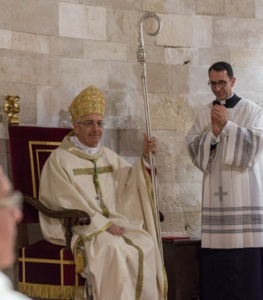
Archbishop Mgr. Leonardo D’Ascenzo
“I stand at the door and knock ” (Rev. 3:20)
Click here for website
On Saturday January 27, the Archdiocese of Trani-Barletta-Bisceglie joyfully welcomed its new Archbishop Mgr. Leonardo D’Ascenzo, after having lived the important day of his Episcopal Ordination, held on Sunday January 14 in the “Bandinelli” Palasport, in Velletri .
After being received in the early afternoon by the mayor of Trani and the diocesan Administrator Mgr. Giuseppe Pavone, Archbishop D’Ascenzo went first to the Caritas dormitory named after his predecessor, Mgr.Giovan Battista Pichierri, where he met a group of immigrant women.This is a sign of attention towards the last, already manifest at the dawn of his episcopal ministry and that it is also possible to see in his greeting to the civil and military authorities that was held immediately afterwards. In fact, addressing himself to them, he affirmed: “… I thought that if the Lord had not called me to the priesthood, I would have had no difficulty in devoting myself to political life, seen as a service to the ‘polis’, to the human community, because I see a common fundamental element between political commitment and priestly ministry, that is, as service to the people and to the person. This makes our lives precious and noble: the service to the common good and to the good of the individual, especially of the little ones, that is, the poor, the elderly, the sick, those who have erred, the weakest… ” And, then, citing the example of Giorgio La Pira, the holy mayor of Florence who looked to a world without barriers, to the expectations of the poor, he emphasized that “we are all Samaritans, everyone … Every day we have to go down from Jerusalem to Jericho …. The parable of the Good Samaritan is an invitation to come down, to go towards the last who are in need and ask for our help “. Hence his exhortation “Let us never forget to attend the school of service and respect for the person, as such, without distinction or discrimination of any kind … This is particularly true today ‘day of remembrance’ in which we commemorate all the victims of the holocaust;let’s pray for them, because this horror never happens again. “
Accompanied by the faithful who enthusiastically greeted him along the way, Archbishop D’Ascenzo afterwards proceeded to the Church of San Giovanni to meet the clergy, the religious and consecrated people, the deacons and seminarians of the diocese. The impression about him is that of a man belonging to the people: he stopped, he embraced, he greeted people familiarly and blessed all those who approached him.
Then, he arrived at the Church and after kneeling for a few minutes before the Crucifix and having listened to the greeting of Mgr. Pavone on behalf of the whole diocesan Church of Trani, Barletta, Bisceglie, in his speech he highlighted that all the clergy is invited to live a real communion and a profound and true friendship, because it is only this that allows us to give an authentic testimony to Christ. And recalling the words taken from a text very familiar and dear to him”NEW VOCATIONS FOR A NEW EUROPE” – Final Document of the Congress on Vocations to the Priesthood and to Consecrated Life in Europe (1997) he said that “the first testimony we are called to give is the gift of our life “.
“Life – he quoted-is a good received which, by its nature, tends to become a good given. It is the truth of life, its logic: good received, good given! “And echoing Pope Francis, he continued clarifying that ‘though it is true that this mission demands great generosity on our part, it would be wrong to see it as a heroic individual undertaking… the primacy always belongs to God, who has called us to cooperate with him and who leads us on by the power of his Spirit “(EG12).
Then, starting from the Church of San Giovanni, there was the procession with which His Exc. Mgr. Leonardo D’Ascenzo entered the Cathedral for the solemn Celebration of the Eucharist. Among those present, in addition to the numerous bishops and civil authorities, also the Archbishop’s family, the new dean of the Pontifical Leoniano Collegio in Anagni, a large delegation of the Diocese of Velletri – Segni, some representatives of other religious faiths, as well as some members of Mgr. Pichierri’s family who wanted to take part in the solemn liturgy.
Mgr. D’Ascenzo greeted the many faithful who were in the cathedral recalling a passage from the Book of Revelation, the letter to the Church of Laodicea: “Behold, I stand at the door and knock. If anyone hears my voice and opens the door, I will come in to him and eat with him, and he with me.”(Rev 3: 20)”The door mentioned today by Jesus is the door of the heart of this Church of Trani-Barletta-Bisceglie, it is the door of each of you, in front of which I want to stand discreetly, knock gently to enter and eat, that is, to share the Bread, the Bread of life which is Jesus“.
«And I, when I came to you, brothers, did not come proclaiming to you the testimony of God with lofty speech or wisdom. For I decided to know nothing among you except Jesus Christ and him crucified. And I was with you in weakness and in fear and much trembling, and my speech and my message were not in plausible words of wisdom, but in demonstration of the Spirit and of power, so that your faith might not rest in the wisdom of men but in the power of God».With these words of St. Paul to the Corinthians, during his first homily, the Archbishop referred to his mandate: “I am aware of my limitations and weaknesses and therefore I ask the Lord that He uses me so that I can spread His Word “.
He also explained the meaning of the motto he chose “Messis quidem multa”: the harvest is plentiful. “Those words invite us to look at a reality that is able to recognize beauty, the positive things that precede us and accompany us …Those words – he continued – surprise us, because we all know that we must first plow, sow and cultivate in order to harvest abundantly at the right time..Jesus says instead that ‘the harvest is plentiful’. But who worked for the result to be such? The answer is only one: God. We often look at reality with depression and negativity: we should instead direct our gaze on the abundance of the harvest”.
The appointment of Archbishop D’Ascenzo surprised everyone. The Archdiocese of Trani – Barletta Bisceglie is “a Church with long tradition, it is lively, numerically large“, therefore, “it is customary to appoint in it a Bishop who has experience, not newly appointed… I carry with me no experience in this regard. It is this Church, it is youwho will help me to learn the service that lies ahead. For my part, as it is said, I must study “.
We, the Little Children of the Divine Will, would like to express our good wishes to His Excellency so that “this new adventure” as he himself called it, may be enlightened by the Light of the Divine Will; we assure him our prayers for a fruitful episcopal ministry and for all the effort that he will also be called to give to further the process of beatification and canonization of the Servant of God Luisa Piccarreta, so that the Kingdom of God can be fulfilled “on earth as it is in Heaven “.
Fiat!
Antonella
